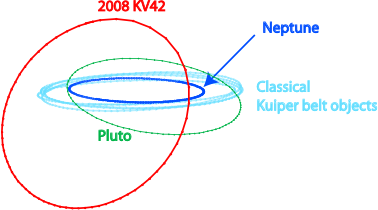The Kuiper Belt is of special interest to astrophysicists because it is a fossil remnant of the primordial debris that formed the planets. University of Victoria Ph.D. student Alex Parker presented his results at today's meeting of the Division of Planetary Sciences in Pasadena, California.
Parker and his thesis supervisor Dr. J.J. Kavelaars (Herzberg Institute of Astrophysics) studied binaries; systems of two objects that, like the Earth and the moon, travel around the sun while orbiting around each other. Binaries are very common in the Kuiper Belt. Using computer simulations, the researchers determined that binary systems in part of the Belt would have been destroyed by any interaction with the giant planet.

Neptune in relation to Kuiper belt with Trans-Neptunian object 2008 KV42 for reference. Credit: Canada-France Ecliptic Plane Survey project
"They would not be there today if the members of this part of the Kuiper Belt were ever hassled by Neptune in the past," says Parker. "It suggests that this region formed near its present location and remained undisturbed over the age of the solar system.
"Understanding the structure and history of the Kuiper Belt helps us better understand how the planets in our solar system formed, and how planets around other stars may be forming today."
The research will be published in an upcoming edition of Astrophysical Journal Letters.
Citation: Alex H. Parker, JJ Kavelaars, 'Destruction of Binary Minor Planets During Neptune Scattering', arXiv:1009.3495v1




Comments